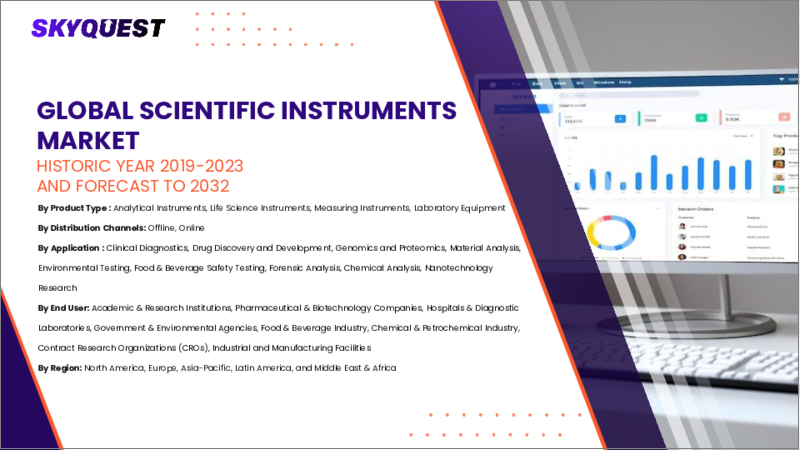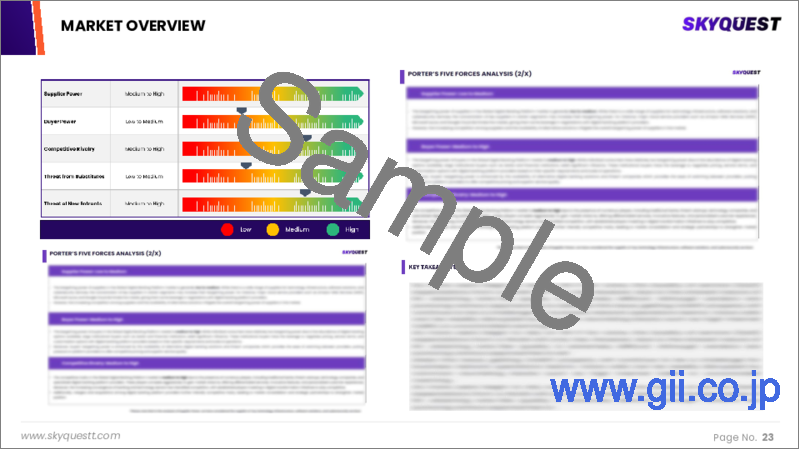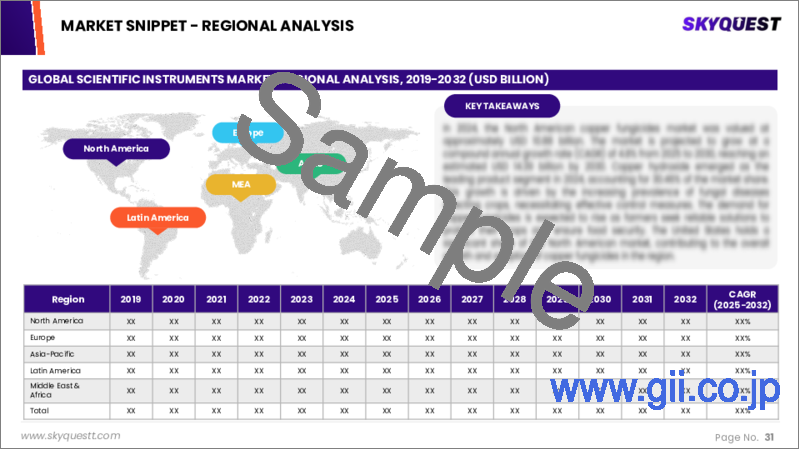|
|
市場調査レポート
商品コード
1663024
科学機器の市場規模、シェア、成長分析、製品別、用途別、エンドユーザー別、地域別 - 産業予測、2025-2032年Scientific Instruments Market Size, Share, and Growth Analysis, By Product (Scientific Analyzers Instruments, Scientific Clinical Instruments), By Application (Research, Clinical & Diagnostics), By End User, By Region - Industry Forecast 2025-2032 |
||||||
|
|||||||
| 科学機器の市場規模、シェア、成長分析、製品別、用途別、エンドユーザー別、地域別 - 産業予測、2025-2032年 |
|
出版日: 2025年02月21日
発行: SkyQuest
ページ情報: 英文 219 Pages
納期: 3~5営業日
|
全表示
- 概要
- 目次
科学機器の世界市場規模は2023年に413億米ドルとなり、予測期間(2025-2032年)のCAGRは4.8%で、2024年の432億8,000万米ドルから2032年には629億8,000万米ドルに成長する見通しです。
世界の科学機器市場は、さまざまな科学分野における研究、分析、実験をサポートする活気に満ちた発展分野です。技術革新を促進し、画期的な発見を容易にするために不可欠なこの市場には、生命科学、化学、物理学などで利用される顕微鏡、クロマトグラフィーシステム、分光装置などのツールが多数含まれています。主な成長要因としては、研究開発活動の活発化、技術の進歩、精密測定のニーズの高まりなどが挙げられます。自動化や人工知能のような技術革新は、これらの機器の有効性を高め、データ収集と分析の改善を可能にしています。さらに、製薬・バイオテクノロジー分野の拡大、環境規制への要求が、高度な計測器の必要性を高めています。地域的には、確立された研究センターや新興経済国が科学インフラに投資し、学界、産業界、政府機関の戦略的協力関係によって補完されることで、需要に拍車がかかっています。
目次
イントロダクション
- 調査の目的
- 調査範囲
- 定義
調査手法
- 情報調達
- 二次と一次データの方法
- 市場規模予測
- 市場の前提条件と制限
エグゼクティブサマリー
- 世界市場の見通し
- 供給と需要の動向分析
- セグメント別機会分析
市場力学と見通し
- 市場概要
- 市場規模
- 市場力学
- 促進要因と機会
- 抑制要因と課題
- ポーターの分析
主な市場の考察
- 重要成功要因
- 競合の程度
- 主な投資機会
- 市場エコシステム
- 市場の魅力指数(2024年)
- PESTEL分析
- マクロ経済指標
- バリューチェーン分析
- 価格分析
- 規制情勢
- ケーススタディ
- 技術の進歩
- 特許分析
科学機器市場規模:製品別
- 市場概要
- 科学分析機器
- 科学臨床機器
- その他
科学機器市場規模:用途別
- 市場概要
- 研究
- 臨床および診断
- その他
科学機器市場規模:エンドユーザー別
- 市場概要
- 病院および診断研究所
- 政府機関
- 製薬・バイオテクノロジー企業
- その他
科学機器市場規模
- 北米
- 米国
- カナダ
- 欧州
- ドイツ
- スペイン
- フランス
- 英国
- イタリア
- その他欧州地域
- アジア太平洋地域
- 中国
- インド
- 日本
- 韓国
- その他アジア太平洋地域
- ラテンアメリカ
- ブラジル
- その他ラテンアメリカ地域
- 中東・アフリカ
- GCC諸国
- 南アフリカ
- その他中東・アフリカ
競合情報
- 上位5社の比較
- 主要企業の市場ポジショニング(2024年)
- 主な市場企業が採用した戦略
- 最近の市場動向
- 企業の市場シェア分析(2024年)
- 主要企業の企業プロファイル
- 企業の詳細
- 製品ポートフォリオ分析
- 企業のセグメント別シェア分析
- 収益の前年比比較(2022-2024)
主要企業プロファイル
- Thermo Fisher Scientific(United States)
- Agilent Technologies(United States)
- PerkinElmer(United States)
- Waters Corporation(United States)
- Bruker Corporation(United States)
- Danaher Corporation(United States)
- Shimadzu Corporation(Japan)
- Horiba, Ltd.(Japan)
- JEOL Ltd.(Japan)
- Hitachi High-Tech Corporation(Japan)
- Mettler-Toledo International Inc.(United States)
- Anton Paar GmbH(Austria)
- Heraeus Holding GmbH(Germany)
- Tecan Group Ltd.(Switzerland)
- Oxford Instruments plc(United Kingdom)
- Malvern Panalytical Ltd.(United Kingdom)
- Sartorius AG(Germany)
- Eppendorf AG(Germany)
- Zeiss Group(Germany)
- ABB Ltd.(Switzerland)
結論と提言
Global Scientific Instruments Market size was valued at USD 41.3 billion in 2023 and is poised to grow from USD 43.28 billion in 2024 to USD 62.98 billion by 2032, growing at a CAGR of 4.8% during the forecast period (2025-2032).
The global scientific instruments market is a vibrant and evolving sector instrumental in supporting research, analysis, and experimentation across various scientific fields. Critical for fostering innovation and facilitating groundbreaking discoveries, the market encompasses an array of tools including microscopes, chromatography systems, and spectroscopy devices, utilized in life sciences, chemistry, physics, and more. Key growth drivers include increased R&D activities, technological advancements, and a growing need for precision measurements. Innovations like automation and artificial intelligence are enhancing the efficacy of these instruments, allowing for improved data collection and analysis. Additionally, the expansion of the pharmaceutical and biotechnology sectors, alongside environmental regulatory demands, is boosting the necessity for sophisticated instrumentation. Geographically, demand is spurred by established research centers and emerging economies investing in scientific infrastructure, complemented by strategic collaborations among academia, industry, and government entities.
Top-down and bottom-up approaches were used to estimate and validate the size of the Global Scientific Instruments market and to estimate the size of various other dependent submarkets. The research methodology used to estimate the market size includes the following details: The key players in the market were identified through secondary research, and their market shares in the respective regions were determined through primary and secondary research. This entire procedure includes the study of the annual and financial reports of the top market players and extensive interviews for key insights from industry leaders such as CEOs, VPs, directors, and marketing executives. All percentage shares split, and breakdowns were determined using secondary sources and verified through Primary sources. All possible parameters that affect the markets covered in this research study have been accounted for, viewed in extensive detail, verified through primary research, and analyzed to get the final quantitative and qualitative data.
Global Scientific Instruments Market Segments Analysis
Global Scientific Instruments Market is segmented by Product, Application, End User and region. Based on Product, the market is segmented into Scientific Analyzers Instruments, Scientific Clinical Instruments and Others. Based on Application, the market is segmented into Research, Clinical & Diagnostics and Others. Based on End User, the market is segmented into Hospitals & Diagnostic Laboratories, Government Institutes, Pharmaceutical & Biotechnology Companies and Others. Based on region, the market is segmented into North America, Europe, Asia Pacific, Latin America and Middle East & Africa.
Driver of the Global Scientific Instruments Market
The Global Scientific Instruments market is significantly influenced by ongoing technological advancements. Innovations in sectors such as biotechnology, nanotechnology, and materials science create a growing need for state-of-the-art instruments that provide enhanced precision, sensitivity, and automation. As researchers and various industries increasingly depend on these sophisticated tools for conducting intricate experiments and analyses, the demand for such instruments continues to rise. This reliance on advanced scientific devices is a crucial factor contributing to the overall expansion and evolution of the market, highlighting the importance of innovation in driving growth in the scientific instruments industry.
Restraints in the Global Scientific Instruments Market
The global scientific instruments market faces a notable constraint stemming from the high costs associated with advanced technology and specialized equipment. The substantial upfront investment required can discourage smaller research institutions and startups from purchasing these instruments, thereby restricting their access to essential tools needed for research and development. This financial barrier not only hampers the growth potential of the market but also limits innovation, as smaller entities often play a crucial role in driving advancements. Consequently, the overall accessibility of cutting-edge scientific instruments is diminished, impacting the expansion and diversification of the market landscape.
Market Trends of the Global Scientific Instruments Market
The Global Scientific Instruments market is experiencing a notable trend characterized by the rise of precision and miniaturization. Driven by advancements in nanotechnology and microfabrication, manufacturers are developing compact instruments that enhance sensitivity and accuracy, enabling diverse applications spanning medical diagnostics and environmental monitoring. This shift is propelled by an increasing demand for point-of-care testing and field research, prioritizing the reduction of sample and reagent consumption. Consequently, companies are investing in innovative, miniaturized solutions that deliver high performance within smaller form factors, setting a new standard for usability and efficiency in scientific research and diagnostics.
Table of Contents
Introduction
- Objectives of the Study
- Scope of the Report
- Definitions
Research Methodology
- Information Procurement
- Secondary & Primary Data Methods
- Market Size Estimation
- Market Assumptions & Limitations
Executive Summary
- Global Market Outlook
- Supply & Demand Trend Analysis
- Segmental Opportunity Analysis
Market Dynamics & Outlook
- Market Overview
- Market Size
- Market Dynamics
- Drivers & Opportunities
- Restraints & Challenges
- Porters Analysis
- Competitive rivalry
- Threat of substitute
- Bargaining power of buyers
- Threat of new entrants
- Bargaining power of suppliers
Key Market Insights
- Key Success Factors
- Degree of Competition
- Top Investment Pockets
- Market Ecosystem
- Market Attractiveness Index, 2024
- PESTEL Analysis
- Macro-Economic Indicators
- Value Chain Analysis
- Pricing Analysis
- Regulatory Landscape
- Case Studies
- Technological Advancement
- Patent Analysis
Global Scientific Instruments Market Size by Product & CAGR (2025-2032)
- Market Overview
- Scientific Analyzers Instruments
- Scientific Clinical Instruments
- Others
Global Scientific Instruments Market Size by Application & CAGR (2025-2032)
- Market Overview
- Research
- Clinical & Diagnostics
- Others
Global Scientific Instruments Market Size by End User & CAGR (2025-2032)
- Market Overview
- Hospitals & Diagnostic Laboratories
- Government Institutes
- Pharmaceutical & Biotechnology Companies
- Others
Global Scientific Instruments Market Size & CAGR (2025-2032)
- North America (Product, Application, End User)
- US
- Canada
- Europe (Product, Application, End User)
- Germany
- Spain
- France
- UK
- Italy
- Rest of Europe
- Asia Pacific (Product, Application, End User)
- China
- India
- Japan
- South Korea
- Rest of Asia-Pacific
- Latin America (Product, Application, End User)
- Brazil
- Rest of Latin America
- Middle East & Africa (Product, Application, End User)
- GCC Countries
- South Africa
- Rest of Middle East & Africa
Competitive Intelligence
- Top 5 Player Comparison
- Market Positioning of Key Players, 2024
- Strategies Adopted by Key Market Players
- Recent Developments in the Market
- Company Market Share Analysis, 2024
- Company Profiles of All Key Players
- Company Details
- Product Portfolio Analysis
- Company's Segmental Share Analysis
- Revenue Y-O-Y Comparison (2022-2024)
Key Company Profiles
- Thermo Fisher Scientific (United States)
- Company Overview
- Business Segment Overview
- Financial Updates
- Key Developments
- Agilent Technologies (United States)
- Company Overview
- Business Segment Overview
- Financial Updates
- Key Developments
- PerkinElmer (United States)
- Company Overview
- Business Segment Overview
- Financial Updates
- Key Developments
- Waters Corporation (United States)
- Company Overview
- Business Segment Overview
- Financial Updates
- Key Developments
- Bruker Corporation (United States)
- Company Overview
- Business Segment Overview
- Financial Updates
- Key Developments
- Danaher Corporation (United States)
- Company Overview
- Business Segment Overview
- Financial Updates
- Key Developments
- Shimadzu Corporation (Japan)
- Company Overview
- Business Segment Overview
- Financial Updates
- Key Developments
- Horiba, Ltd. (Japan)
- Company Overview
- Business Segment Overview
- Financial Updates
- Key Developments
- JEOL Ltd. (Japan)
- Company Overview
- Business Segment Overview
- Financial Updates
- Key Developments
- Hitachi High-Tech Corporation (Japan)
- Company Overview
- Business Segment Overview
- Financial Updates
- Key Developments
- Mettler-Toledo International Inc. (United States)
- Company Overview
- Business Segment Overview
- Financial Updates
- Key Developments
- Anton Paar GmbH (Austria)
- Company Overview
- Business Segment Overview
- Financial Updates
- Key Developments
- Heraeus Holding GmbH (Germany)
- Company Overview
- Business Segment Overview
- Financial Updates
- Key Developments
- Tecan Group Ltd. (Switzerland)
- Company Overview
- Business Segment Overview
- Financial Updates
- Key Developments
- Oxford Instruments plc (United Kingdom)
- Company Overview
- Business Segment Overview
- Financial Updates
- Key Developments
- Malvern Panalytical Ltd. (United Kingdom)
- Company Overview
- Business Segment Overview
- Financial Updates
- Key Developments
- Sartorius AG (Germany)
- Company Overview
- Business Segment Overview
- Financial Updates
- Key Developments
- Eppendorf AG (Germany)
- Company Overview
- Business Segment Overview
- Financial Updates
- Key Developments
- Zeiss Group (Germany)
- Company Overview
- Business Segment Overview
- Financial Updates
- Key Developments
- ABB Ltd. (Switzerland)
- Company Overview
- Business Segment Overview
- Financial Updates
- Key Developments





